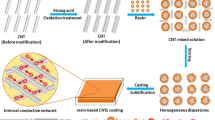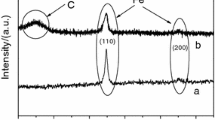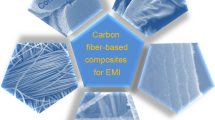Abstract
Exploiting the electromagnetic wave absorbers with high microwave absorption performance by establishing the heterostructure in the carbon-based materials is an exciting strategy to address the issue of electromagnetic pollution. CoFe or Co alloy is introduced into carbon-based absorbing materials to optimize the impedance matching and enhance the magnetic loss. Herein, CoFe/C heterostructured fiber composites are prepared from the discarded cigarette filters by the wet chemical immersion and subsequent calcination for high-quality light microwave absorbing materials. The CoFe/C fiber composites calcined at 950 °C temperature remarkably achieve a − 53.8 dB strong reflection loss value at 1.57 mm matching thickness and 5.3 GHz broad bandwidth. This work should provide an effective strategy for the utilization of discarded cigarette filters as high microwave absorption performance materials.










Similar content being viewed by others
Data availability
All data generated or analyzed during this study are included in this published article and its supplementary information files. All data sharing and data citation is encouraged.
References
B. Rka, C. Ss, D. Ej et al., Recent progress on carbon-based composite materials for microwave electromagnetic interference shielding. Carbon 177, 304–331 (2021). https://doi.org/10.1016/j.carbon.2021.02.091
S. Acharya, P. Alegaonkar, S. Datar, Effect of formation of heterostructure of SrAl4Fe8O19/RGO/PVDF on the microwave absorption properties of the composite. Chem. Eng. J. 374, 144–154 (2019). https://doi.org/10.1016/j.cej.2019.05.078
B. Wang, Q. Wu, Y. Fu et al., A review on carbon/magnetic metal composites for microwave absorption. J. Mater. Sci. Technol. 86, 91–109 (2021). https://doi.org/10.1016/j.jmst.2020.12.078
C.C.Z.F. Wu, M.M. Wang, X. Cao, Y. Zhang, P. Song, T.Y. Zhang, X.L. Ye, Y. Yang, W.H. Gu, J.D. Zhou, Y.Z. Huang, Confining tiny MoO2 clusters into reduced graphene oxide for highly efficient low frequency microwave absorption. Small 16(30), 2001686 (2020). https://doi.org/10.1002/smll.202001686
X. Zeng, X. Cheng, R. Yu et al., Electromagnetic microwave absorption theory and recent achievements in microwave absorbers. Carbon 168(6), 606–623 (2020). https://doi.org/10.1016/j.carbon.2020.07.028
D. Zhi, T. Li, J. Li et al., A review of three-dimensional graphene-based aerogels: synthesis, structure and application for microwave absorption. Compos. B 211, 108642 (2021). https://doi.org/10.1016/j.compositesb.2021.108642
S. Gao, G. Wang, L. Guo et al., Tunable and ultraefficient microwave absorption properties of trace N-doped two-dimensional carbon-based nanocomposites loaded with multi-rare earth oxides. Small 16(19), 1906668 (2020). https://doi.org/10.1002/smll.201906668
S. Gao, S.H. Yang, H.Y. Wang et al., Excellent electromagnetic wave absorbing properties of two-dimensional carbon-based nanocomposite supported by transition metal carbides Fe3C. Carbon 162, 438–444 (2020). https://doi.org/10.1016/j.carbon.2020.02.031
X. Li, M. Cao, X. Pang et al., Microtubule-based hierarchical porous carbon for lightweight and strong wideband microwave absorption. J. Mat. Chem. 9(5), 1649–1656 (2021). https://doi.org/10.1039/D0TC04486E
J. Xu, Y. Cui, J. Wang et al., Fabrication of wrinkled carbon microspheres and the effect of surface roughness on the microwave absorbing properties. Chem. Eng. J. 401(16), 126027 (2020). https://doi.org/10.1016/j.cej.2020.126027
W. Yang, B. Jiang, Z. Liu et al., Magnetic coupling engineered porous dielectric carbon within ultralow filler loading toward tunable and high-performance microwave absorption. J. Mater. Sci. Technol. 70, 214–223 (2021). https://doi.org/10.1016/j.jmst.2020.08.059
L. Yuan, B. Zheng, J. Kunstmann et al., Twist-angle-dependent interlayer exciton diffusion in WS2-WSe2 heterobilayers. Nat. Mat. 46(8), 617–623 (2020). https://doi.org/10.1038/s41563-020-0670-3
Y. Wei, K. Zhong, T. Jiang et al., Gumdrop-cake-like CuNi/C nanofibers with tunable microstructure for microwave absorbing application. Ceram. Int. 46(8), 11406–11415 (2020). https://doi.org/10.1016/j.ceramint.2020.01.171
H. Zhao, X. Xu, Y. Wang et al., Heterogeneous interface induced the formation of hierarchically hollow carbon microcubes against electromagnetic pollution. Small 16(43), 2003407 (2020). https://doi.org/10.1002/smll.202003407
J. Li, F. Zhang, H. Lu et al., Heterogeneous rod-like Ni@C composites toward strong and stable microwave absorption performance. Carbon 181, 358–369 (2021). https://doi.org/10.1016/j.carbon.2021.05.031
P. Liu, S. Gao, W. Huang et al., Hybrid zeolite imidazolate framework derived N-implanted carbon polyhedrons with tunable heterogeneous interfaces for strong wideband microwave attenuation. Carbon 159, 83–93 (2020). https://doi.org/10.1016/j.carbon.2019.12.021
P. Liu, S. Gao, X. Liu et al., Rational construction of hierarchical hollow CuS@CoS2 nanoboxes with heterogeneous interfaces for high-efficiency microwave absorption materials. Compos. B 192, 107992 (2020). https://doi.org/10.1016/j.compositesb.2020.107992
B. Yza, B. Hma, B. Ysa et al., TiN/Ni/C ternary composites with expanded heterogeneous interfaces for efficient microwave absorption. Compos. B 193, 108028 (2020). https://doi.org/10.1016/j.compositesb.2020.108028
Y. Zhao, W. Wang, J. Wang et al., Constructing multiple heterogeneous interfaces in the composite of bimetallic MOF-derivatives and rGO for excellent microwave absorption performance. Carbon 173, 1059–1072 (2021). https://doi.org/10.1016/j.carbon.2020.11.090
L.A. Di, A. Zg, A. Zz et al., Double-shell hollow glass microspheres@Co2SiO4 for lightweight and efficient electromagnetic wave absorption. Chem. Eng. J. 408, 127313 (2020). https://doi.org/10.1016/j.cej.2020.127313
R. Peymanfar, A. Ahmadi, E. Selseleh-Zakerin et al., Electromagnetic and optical characteristics of wrinkled Ni nanostructure coated on carbon microspheres. Chem. Eng. J. 405, 126985 (2021). https://doi.org/10.1016/j.cej.2020.126985
J. Qiao, X. Zhang, C. Liu et al., Facile fabrication of Ni embedded TiO2/C core-shell ternary nanofibers with multicomponent functional synergy for efficient electromagnetic wave absorption. Compos. B 200, 108343 (2020). https://doi.org/10.1016/j.compositesb.2020.108343
J. Tao, J. Zhou, Z. Yao et al., Multi-shell hollow porous carbon nanoparticles with excellent microwave absorption properties. Carbon 172, 542–555 (2021). https://doi.org/10.1016/j.carbon.2020.10.062
G. Wang, S. On, Y. Zhao et al., Integrated multifunctional macrostructures for electromagnetic wave absorption and shielding. J. Mater. Chem. A 8(46), 24368–24387 (2020). https://doi.org/10.1039/D0TA08515D
Y. Wang, X. Di, Z. Lu et al., Controllable heterogeneous interfaces of cobalt/carbon nanosheets/rGO composite derived from metal-organic frameworks for high-efficiency microwave attenuation. Carbon 187, 404–414 (2022). https://doi.org/10.1016/j.carbon.2021.11.027
R. Qin, A. Ou, Y. Li et al., Noticeably enhanced microwave absorption performance via constructing molecular-level interpenetrating carbon network heterostructure. Carbon 183(1), 858–871 (2021). https://doi.org/10.1016/j.carbon.2021.07.044
W. Huang, X. Zhang, Y. Zhao et al., Hollow N-doped carbon polyhedrons embedded Co and Mo2C nanoparticles for high-efficiency and wideband microwave absorption. Carbon 167, 19–30 (2020). https://doi.org/10.1016/j.carbon.2020.05.073
W. Gu, X. Cui, J. Zheng et al., Heterostructure design of Fe3N alloy/porous carbon nanosheet composites for efficient microwave attenuation. J. Mater. Sci. Technol. 67, 265–272 (2021). https://doi.org/10.1016/j.jmst.2020.06.054
M. He, Y. Zhou, T. Huang et al., Flower-like CoS hierarchitectures@polyaniline organic-inorganic heterostructured composites: preparation and enhanced microwave absorption performance. Compos. Sci. Technol. 200, 108403 (2020). https://doi.org/10.1016/j.compscitech.2020.108403
S.U. Rehman, J. Wang, Q. Luo et al., Starfish-like C/CoNiO2 heterostructure derived from ZIF-67 with tunable microwave absorption properties. Chem. Eng. J. 373, 122–130 (2019). https://doi.org/10.1016/j.cej.2019.05.040
X. Su, J. Wang, X. Zhang et al., Construction of sandwich-like NiCo2O4/graphite nanosheets/NiCo2O4 heterostructures for a tunable microwave absorber. Ceram. Int. 46(11), 19293–19301 (2020). https://doi.org/10.1016/j.ceramint.2020.04.269
J. Wang, Q. Li, J. Ren et al., Synthesis of bowknot-like N-doped Co@C magnetic nanoparticles constituted by a cicular structural units for excellent microwave absorption. Carbon 181, 28–39 (2021). https://doi.org/10.1016/j.carbon.2021.05.028
X. Zhou, Y. Wang, C. Gong et al., Production, structural design, functional control, and broad applications of carbon nanofiber-based nanomaterials: a comprehensive review. Chem. Eng. J. 402, 126189 (2020). https://doi.org/10.1016/j.cej.2020.126189
L.X. Li, C. Jia, X. Zhu et al., Utilization of cigarette butt waste as functional carbon precursor for supercapacitors and adsorbents. J. Clean. Prod. 256, 120326 (2020). https://doi.org/10.1016/j.jclepro.2020.120326
H. Xu, Y. Liu, Q. Bai et al., Discarded cigarette filter-derived hierarchically porous carbon@graphene composites for lithium–sulfur batteries. J. Mater. Chem. A 7(8), 3558–3562 (2019). https://doi.org/10.1039/C8TA11615F
B. Wang, H. Chen, S. Wang et al., Construction of core-shell structured Co7Fe3@C nanocapsules with strong wideband microwave absorption at ultra-thin thickness. Carbon 184, 223–231 (2021). https://doi.org/10.1016/j.carbon.2021.08.009
Y. Xiong, L. Xu, C. Yang et al., Implanting FeCo/C nanocages with tunable electromagnetic parameters in anisotropic wood carbon aerogels for efficient microwave absorption. J. Mater. Chem. A 8, 18863–18871 (2020). https://doi.org/10.1039/D0TA05540A
X. Liang, Z. Man, B. Quan et al., Environment-stable CoxNiy encapsulation in stacked porous carbon nanosheets for enhanced microwave absorption. Nano-Micro Lett. 12(8), 12 (2020). https://doi.org/10.1007/s40820-020-00432-2
P. Liu, S. Gao, G. Zhang et al., Hollow engineering to Co@N-doped carbon nanocages via synergistic protecting-etching strategy for ultrahigh microwave absorption. Adv. Func. Mater. 31, 27 (2021). https://doi.org/10.1002/adfm.202102812
A. Hz, C.A. Yan, Z.A. Zhu et al., Rational design of core-shell Co@C nanotubes towards lightweight and high-efficiency microwave absorption. Compos. B 196, 108119 (2020). https://doi.org/10.1016/j.compositesb.2020.108119
F. Wu, K. Yang, Q. Li et al., Biomass-derived 3D magnetic porous carbon fibers with a helical/chiral structure toward superior microwave absorption. Carbon 173, 918–931 (2021). https://doi.org/10.1016/j.carbon.2020.11.088
Y.J. Chen, P. Gao, R.X. Wang et al., Porous Fe3O4/SnO2 core/shell nanorods: synthesis and electromagnetic properties. J. Phys. Chem. C 113(23), 10061–10064 (2009). https://doi.org/10.1021/jp902296z
S. Dong, P. Hu, X. Li et al., NiCo2S4 nanosheets on 3D wood-derived carbon for microwave absorption. Chem. Eng. J. 398, 125588 (2020). https://doi.org/10.1016/j.cej.2020.125588
Y.H. Wu, K. Peng, Z. Man et al., A hierarchically three-dimensional CoNi/N-doped porous carbon nanosheets with high performance of electromagnetic wave absorption. Carbon 188, 503–512 (2022). https://doi.org/10.1016/j.carbon.2021.12.025
W.A. Shuang, C.B. Tao, A. Zs et al., Preparation of CoFe@N-doped C/rGO composites derived from CoFe prussian blue analogues for efficient microwave absorption. J. Colloid Interface Sci. 610(2), 395–406 (2021). https://doi.org/10.1016/j.jcis.2021.12.051
L. Xu, J. Tao, X. Zhang et al., Co@N-doped double-shell hollow carbon via self-templating-polymerization strategy for microwave absorption. Carbon 188, 34–44 (2022). https://doi.org/10.1016/j.carbon.2021.11.043
Z. Zhang, Z. Cai, Z. Wang et al., A review on metal-organic framework-derived porous carbon-based novel microwave absorption materials. Nano-Micro Lett. 13(4), 29 (2021). https://doi.org/10.1007/s40820-020-00582-3
J. Cui, X. Wang, L. Huang et al., Environmentally friendly bark-derived co-doped porous carbon composites for microwave absorption. Carbon 187, 115–125 (2022). https://doi.org/10.1016/j.carbon.2021.10.077
S. Wei, T. Chen, Q. Wang et al., Metal-organic framework derived hollow CoFe@C composites by the tunable chemical composition for efficient microwave absorption. J. Colloid Interface Sci. 593, 370–379 (2021). https://doi.org/10.1016/j.jcis.2021.02.120
A. Zs, A. Xl, S. Xin et al., Alginate-templated synthesis of CoFe/carbon fiber composite and the effect of hierarchically porous structure on electromagnetic waveabsorption performance. Carbon 151, 36–45 (2019). https://doi.org/10.1016/j.carbon.2019.05.025
H. Xu, G. Zhang, Y. Wang et al., Size-dependent oxidation-induced phase engineering for MOFs derivatives via spatial confinement strategy toward enhanced microwave absorption. Nano-Micro Lett. 14(1), 102 (2022). https://doi.org/10.1007/s40820-022-00841-5
P. Liu, Y. Wang, G. Zhang et al., Hierarchical engineering of double-shelled nanotubes toward hetero-interfaces induced polarization and microscale magnetic interaction. Adv. Funct. Mater. 32, 33 (2022). https://doi.org/10.1002/adfm.202202588
Funding
This work was supported by National Natural Science Foundation of China (52262012, 51771085, 51571104, 51801087, and 51801088) and the Innovation Fund Project of the Gansu Provincial Department of Education (2021A-030).
Author information
Authors and Affiliations
Contributions
All authors contributed to the study's conception and design. Material preparation, data collection, and analysis were performed by YW, YY, JZ, HS, YW, XW, RX, JL, JZ, and YP. The first draft of the manuscript was written by YW, JZ, and YP. All authors commented on previous versions of the manuscript. All authors read and approved the final manuscript.
Corresponding authors
Ethics declarations
Conflict of interest
There are no conflict to declare.
Additional information
Publisher's Note
Springer Nature remains neutral with regard to jurisdictional claims in published maps and institutional affiliations.
Supplementary Information
Below is the link to the electronic supplementary material.
Rights and permissions
Springer Nature or its licensor holds exclusive rights to this article under a publishing agreement with the author(s) or other rightsholder(s); author self-archiving of the accepted manuscript version of this article is solely governed by the terms of such publishing agreement and applicable law.
About this article
Cite this article
Wei, Y., Yu, Y., Zhu, J. et al. CoFe/C heterostructured fiber composites derived from discarded cigarette filters for excellent microwave absorption. J Mater Sci: Mater Electron 33, 24920–24932 (2022). https://doi.org/10.1007/s10854-022-09201-w
Received:
Accepted:
Published:
Issue Date:
DOI: https://doi.org/10.1007/s10854-022-09201-w




